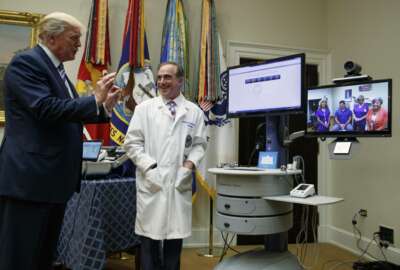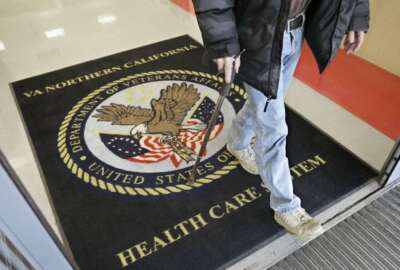
VA’s telehealth program is already the largest in the nation. It’s about to get bigger
The Department of Veterans Affairs is partnering with private sector companies to expand its growing telehealth program.
Best listening experience is on Chrome, Firefox or Safari. Subscribe to Federal Drive’s daily audio interviews on Apple Podcasts or PodcastOne.
The Department of Veterans Affairs documented the first instance of “telehealth” in the early 1960s — when VA doctors communicated with their patients via TV screens.
Today, VA has the largest telehealth program in the United States, and it’s about to get bigger.
The department announced Thursday it will partner with three private sector companies and two veterans service organizations to address VA’s access challenges and create more convenient opportunities for veterans to see doctors and health care professionals.
The announcement came at VA’s first-ever “Anywhere to Anywhere Together” summit in Washington. The department gathered its new partners, members of industry, medical professionals and others to solicit their feedback and ideas on how VA could forge a path for telehealth in the future.
The department is partnering with T-Mobile, which will host the VA Video Connect app on all service devices for free. Veterans who already have T-Mobile don’t need to take action to start or continue using the free service, said Mike Katz, executive vice president of T-Mobile for Business.
Video Connect lets VA providers use their mobile devices to see and speak with veterans on their own devices or home computers.
VA also inked new partnerships with Walmart and Philips. The department will work with Philips, the American Legion and the Veterans of Foreign Wars to set up 10 remote examination services at VSO posts across the country. Philips will provide video screens and other remote medical devices, so veterans can go visit their closest VSO post to see a VA medical professional, who, in some cases, may be based hundreds or even thousands miles away.
Walmart has also agreed to set up remote examination services at some of their stores across the country, so veterans can access the same telehealth services.
“[It] totally changes the VA’s footprint for delivering care,” Deborah Scher, executive adviser to the Secretary’s Center for Strategic Partnerships at the department, said. “We mapped out where our veterans are in greatest concentration against VA facilities, and then we put the Walmart map on top of that. Ninety percent of Americans live within 10 miles of a Walmart. Ninety percent of veterans don’t live within 10 miles of a VA medical center. This totally changes their ability to access care in a way that works for their lives.”
The public and members of Congress have become more aware in recent years about the challenges many veterans experience simply getting to and from their closest VA medical facility.
From the White House, former VA Secretary David Shulkin announced plans to expand the department’s “anywhere to anywhere” telehealth services back in 2017. Those initiatives at the time were geared more toward clearing the administrative barriers that prevented doctors and other health professionals from seeing veteran patients in states other than the state where they were licensed to practice.
Today, VA sees its telehealth program as an opportunity to reach the rural veteran population, where affordable broadband isn’t always widespread or consistent.
“A lot of them don’t have broadband access in their home yet,” Scher said. “We think that will change. But either they can’t afford it or it’s not available where they live. One-third of our veterans are in rural areas, and it’s spotty.”
Scher said VA has broached the topic of offering free VA Video Connect services and expanding telehealth with other companies, including all major phone providers. More partnerships are in the works, she said.
Katz said T-Mobile doesn’t know exactly how many veteran customers it has. Offering free VA Video Connect services should extend past the veteran population to their families and caregivers, he said.
“We know we have a significant number of them,” Katz said. “Since all veterans don’t self-report, we don’t know how large the population is. We hope it makes a huge impact. I hope this encourages all wireless companies to do this, because you shouldn’t just be limited to these services if you’re a T-Mobile customer.”
The department also sees telehealth as an opportunity to reach veterans who aren’t currently active participants in the VA system, and expanding its reach may help more veterans access mental health services.
“Mental health is still the last, great uncharted frontier in medicine,” VA Secretary Robert Wilkie said. “Telehealth, to me, is the first step in finally breaking those last barriers. It allows our veterans who may have those issues to talk to our professionals [and] talk to our doctors without the pressure that they would encounter in a public setting, without the pressures that they would encounter in traditional medical service facilities.”
For Marine Corps and Army Reserve veteran Evelyn Thomas, telehealth lifted a huge burden for her. Thomas suffers from post-traumatic stress disorder, and the process of driving to, parking and entering the VA facility created anxiety.
“It’s a tremendous relief,” she said. “Not only does it help me, but it helps my family. There were times in the old practice when I would have my appointments, I couldn’t remember leaving the VA, driving down the freeway and getting home. By the time I got home, I was still angry and still upset just from that experience. Now when I use telehealth … I just sit for an hour. My mind rests. I’m peaceful.”
Copyright © 2024 Federal News Network. All rights reserved. This website is not intended for users located within the European Economic Area.
Nicole Ogrysko is a reporter for Federal News Network focusing on the federal workforce and federal pay and benefits.
Follow @nogryskoWFED
Related Stories





